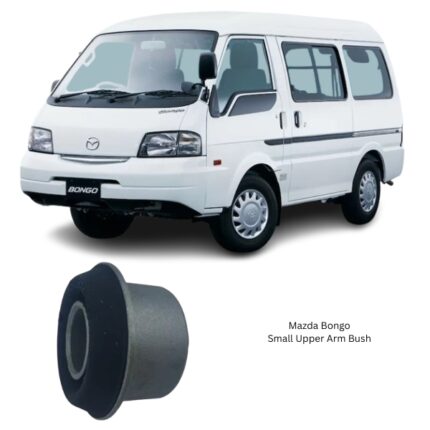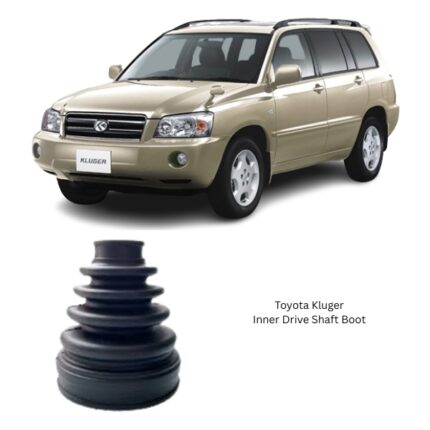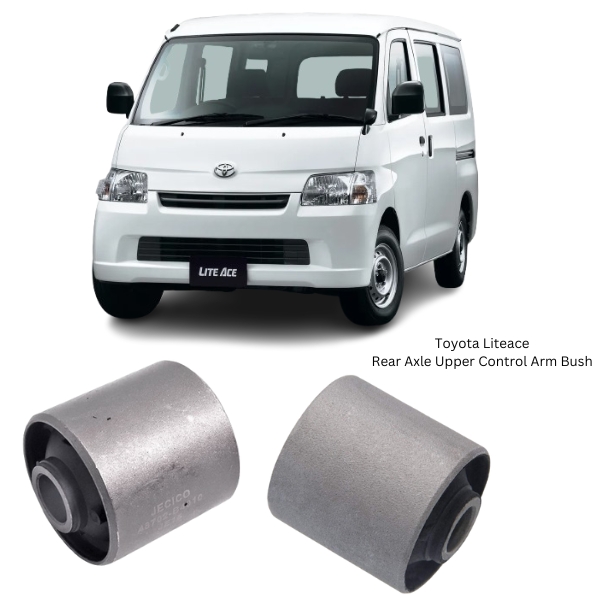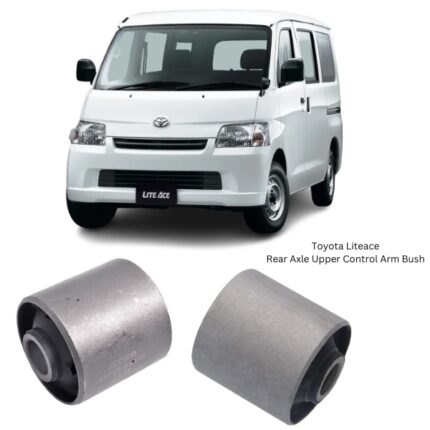-14%
Get Toyota Liteace Rear Axle Upper Control Arm Bush 48702-B4010 in Kenya
The Rear Axle Upper Control Arm Bush is an essential component of a vehicle’s rear suspension system. Though compact in size, its role is critical in preserving alignment, absorbing vibrations, and maintaining the integrity of rear axle articulation. Installed between the rear upper control arm and the vehicle frame or axle housing, this bushing allows for controlled pivoting while dampening road impacts and isolating vibrations.
Its primary function is to ensure smooth and stable suspension movement under varying load conditions. Without a properly functioning rear upper arm bush, the vehicle’s handling, ride quality, and rear suspension geometry can be compromised—leading to instability, uneven tire wear, and increased component wear.
Function and Purpose
In multi-link or control arm suspension systems, the Rear Axle Upper Control Arm Bush serves as a flexible joint between the upper arm and the vehicle structure. It facilitates smooth suspension travel by allowing the control arm to pivot without transmitting harsh road inputs to the body.
Core Functions:
-
Pivoting Support
Provides the necessary range of motion for the upper control arm to respond to road conditions. -
Vibration Isolation
Dampens noise, vibration, and harshness (NVH), ensuring a smoother and quieter ride for vehicle occupants. -
Suspension Geometry Preservation
Maintains rear axle alignment parameters (such as camber and toe), ensuring proper handling and tire contact. -
Load Distribution
Helps distribute dynamic forces between the control arm and chassis evenly, reducing fatigue and stress. -
Rear Axle Stability
Controls lateral and longitudinal forces acting on the rear wheels, particularly during acceleration, braking, and cornering.
By providing controlled movement, the bushing ensures predictable suspension behavior and consistent handling across various driving conditions.
Design and Materials
The Rear Axle Upper Control Arm Bush is engineered to be durable, flexible, and resistant to environmental and mechanical stress. Its design features a metal-sleeved construction with a bonded elastomeric core.
Main Components:
-
Outer Metal Sleeve
This cylindrical casing fits securely into the control arm bracket or bushing housing. -
Inner Metal Sleeve
Receives the control arm bolt and remains static, allowing the elastomeric core to flex during suspension travel. -
Elastomeric Core (Rubber or Polyurethane)
Located between the metal sleeves, this core absorbs road shocks, accommodates pivoting movement, and provides vibration damping.
Material Variations:
-
Rubber
Offers excellent damping characteristics and flexibility, ideal for passenger vehicles prioritizing comfort. -
Polyurethane (PU)
More rigid and wear-resistant, suited for high-performance or heavy-duty vehicles requiring improved control and longevity.
Some versions of the bush are also engineered with voids, slots, or directional reinforcement to optimize compliance along specific movement planes—enhancing comfort or rigidity where needed.
Performance Characteristics
The Rear Axle Upper Control Arm Bush directly influences how the rear suspension reacts under load and during road impact. A high-performance bushing will offer:
-
Excellent Damping Performance
Effectively filters out vibrations and road feedback that would otherwise reach the cabin. -
Consistent Suspension Articulation
Maintains a proper balance between stiffness and flexibility during suspension movement. -
Long Service Life
Designed to withstand harsh conditions including UV exposure, ozone, chemicals, temperature extremes, and cyclic loads. -
Accurate Rear Alignment
Helps keep the rear wheels properly aligned, minimizing tire wear and enhancing driving stability. -
Handling Support
Enhances vehicle control, particularly when cornering or during rapid direction changes.
Common Symptoms of Wear or Failure
Like all suspension bushings, the Rear Axle Upper Control Arm Bush degrades over time due to age, environmental exposure, and repeated stress cycles.
Signs of a Worn or Failing Bushing:
-
Clunking or Knocking Noises
Especially when driving over uneven surfaces or during rapid acceleration and deceleration. -
Excessive Rear-End Vibration
Noticeable through the seat or floorboard, indicating loss of damping ability. -
Unstable Handling
The vehicle may feel loose or unstable, especially around corners or when switching lanes. -
Rear Axle Misalignment
May result in abnormal tire wear or uneven ride height on the rear axle. -
Visible Rubber Damage
Cracks, separation from the metal sleeves, or missing chunks of rubber during visual inspection. -
Vehicle Pulling or Drifting
Due to altered suspension geometry, the vehicle may pull to one side or drift during braking or acceleration.
Ignoring these signs can lead to further damage to the control arm, shocks, or even axle alignment, necessitating more costly repairs.
Installation and Replacement
Replacing the Rear Axle Upper Control Arm Bush typically involves removing the control arm from the vehicle and using a hydraulic press to extract and install the bushing. Precision during installation is essential to maintain suspension geometry and bushing integrity.
General Replacement Procedure:
-
Lift and Secure the Vehicle
Use a lift or jack stands to access the rear suspension safely. -
Remove the Rear Wheel
Gain access to the upper control arm and its mounting points. -
Detach the Control Arm
Remove bolts securing the upper control arm to both the chassis and axle. -
Press Out the Old Bushing
Use a hydraulic or mechanical press to remove the worn bushing from the control arm. -
Install the New Bushing
Carefully press the new bushing into the control arm, ensuring correct orientation and seating. -
Reattach the Control Arm
Torque all fasteners to manufacturer specifications. -
Perform Rear Wheel Alignment
After replacing any suspension component, a wheel alignment is essential to restore factory settings.
Note: It is recommended to replace both left and right upper control arm bushes at the same time to maintain symmetry and consistent handling characteristics.
Maintenance and Inspection
Though the Rear Axle Upper Control Arm Bush is designed to be maintenance-free, it should be inspected periodically, especially if the vehicle is:
-
Frequently driven on rough or unpaved roads
-
Used for towing or carrying heavy loads
-
Exhibiting signs of suspension wear or abnormal rear tire wear
-
Involved in an accident or severe road impact
Routine inspection during service appointments can help identify early signs of wear and prevent more significant suspension issues.
Advantages of Timely Replacement
-
Restores Vehicle Stability
Ensures predictable behavior during acceleration, cornering, and braking. -
Enhances Ride Comfort
Reduces the transmission of road harshness into the passenger cabin. -
Protects Tires and Suspension
Helps avoid premature tire wear and stress on other suspension components. -
Improves Handling Precision
Allows for sharper steering response and improved lane discipline. -
Reduces Long-Term Repair Costs
Prevents the progression of wear to adjacent parts such as the control arms, dampers, and mounts.
Follow us on Facebook for more parts.





Reviews
Clear filtersThere are no reviews yet.